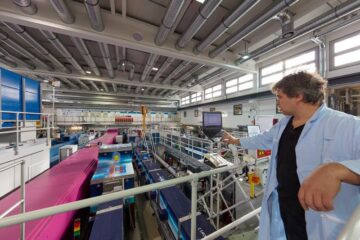Bionas cell profiling device selected by Solvay Pharmaceuticals for Target Validation

„It is known that angiotensin 1-8 (angiotensin II) acts via two receptors. The AT1 receptor mediates vasoconstriction upon stimulation, whereas the AT2 receptor is implicated in hypotensive effects. However, the mechanism through which angiotensin 1-7 induces its powerful hypotensive effect were unclear,“ explains Dr. Eric Ronken, Principal Scientist at Solvay.
On-line monitoring of endothelial cell physiology and its changes upon challenges by angiotensin 1-7 helped in delineating the mechanism of action by this peptide. The Bionas® 2500 analyzing system is well suited for such experiments, as it measures cellular acidification, oxygen consumption and cell adhesion simultaneously in a label-free and non-invasive way. „The Bionas system allows us to extend and optimize target validation studies by bringing the targets back into their physiological context“, says Dr. Eric Ronken.
The Bionas 2500 analyzing system gives a complete overview over the physiologic state of cells. It can be used to discriminate between different signal transduction pathways allowing target validation studies at an early stage in the drug discovery process. Recently, Bionas announced the usefulness of its device to predict liver toxicity in primary human hepatocytes and standardized HepG2 cells.
About Bionas
Bionas GmbH, situated in Rostock, Germany, specializes in analyzing systems and services for in-vitro profiling the metabolic activity of cells to understand cellular function. Bionas® 2500 analyzing system measures extracellular acidification, oxygen consumption and cell adhesion in a label-free and non-invasive way and can be applied to various cell types including primary cells. The readout is carried out continuously and can be watched online. Main applications include drug profiling, lead optimization, pharmaco kinetics, early toxicology programs, ADME/Tox, chemosensitivity testing, toxicological testing of chemical substances (REACH) and cell culture monitoring/optimization. Micronas Holding GmbH and GENIUS Venture Capital GmbH fund the company.
About Solvay
SOLVAY is an international chemical and pharmaceutical Group with headquarters in Brussels. It employs some 30,000 people in 50 countries. In 2005 its consolidated sales amounted to EUR 8.6 billion generated by its three activity sectors: Chemicals, Plastics and Pharmaceuticals. SOLVAY (Euronext : SOLB.BE – Bloomberg: SOLB.BB – Reuters: SOLBt.BR) is listed on the Euronext stock exchange in Brussels.
Contact at Bionas:
Dr. Michael Schulze
Bionas GmbH
Phone: +49 (0) 381 5196-241
email: michael.schulze@bionas.de
Contact at Solvay:
Dr. Eric Ronken
Solvay Pharmaceuticals Research Laboratories
Phone +31(0) 294 479853
e-mail eric.ronken@solvay.com
Media contact:
Dr. Sabine Duntze
b3c communications
Phone: +49 (0) 861 – 909 82 20
email: sduntze@b3c.de
Media Contact
Alle Nachrichten aus der Kategorie: Biowissenschaften Chemie
Der innovations-report bietet im Bereich der "Life Sciences" Berichte und Artikel über Anwendungen und wissenschaftliche Erkenntnisse der modernen Biologie, der Chemie und der Humanmedizin.
Unter anderem finden Sie Wissenswertes aus den Teilbereichen: Bakteriologie, Biochemie, Bionik, Bioinformatik, Biophysik, Biotechnologie, Genetik, Geobotanik, Humanbiologie, Meeresbiologie, Mikrobiologie, Molekularbiologie, Zellbiologie, Zoologie, Bioanorganische Chemie, Mikrochemie und Umweltchemie.
Neueste Beiträge

Bakterien für klimaneutrale Chemikalien der Zukunft
Forschende an der ETH Zürich haben Bakterien im Labor so herangezüchtet, dass sie Methanol effizient verwerten können. Jetzt lässt sich der Stoffwechsel dieser Bakterien anzapfen, um wertvolle Produkte herzustellen, die…

Batterien: Heute die Materialien von morgen modellieren
Welche Faktoren bestimmen, wie schnell sich eine Batterie laden lässt? Dieser und weiteren Fragen gehen Forschende am Karlsruher Institut für Technologie (KIT) mit computergestützten Simulationen nach. Mikrostrukturmodelle tragen dazu bei,…

Porosität von Sedimentgestein mit Neutronen untersucht
Forschung am FRM II zu geologischen Lagerstätten. Dauerhafte unterirdische Lagerung von CO2 Poren so klein wie Bakterien Porenmessung mit Neutronen auf den Nanometer genau Ob Sedimentgesteine fossile Kohlenwasserstoffe speichern können…





















